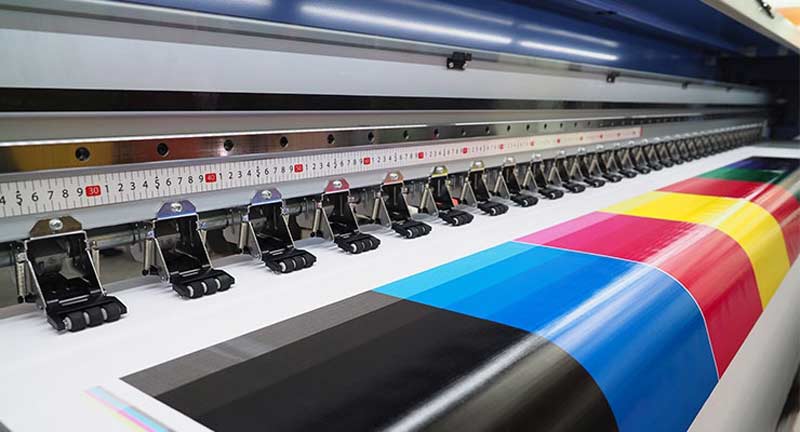IMPACT ON DEMAND OF DIGITAL PRINTING
With the advent of digital technology, capturing information on paper printed these days has become lot more easily through digital printing. Digital printing has suppressed the traditional methods of letterpress and offset printing, which were once very popular among large businesses. But COVID-19 has changed the entire dynamics and impacted all the industrial sectors across the world. Digital printing market domain is no exception and was hit badly due to lack of engagement of their consumers in the industry. The restricted regulation of movement has also affected every aspect of their operation.
The digital printing industry had to change its focus to online transactions and create new printing technologies and strategies due to sudden lockdown restrictions all over the world. Physical shops have been closed for months and the only way to attract consumers is via internet. As the focus shifts to online, a growing number of customers are able to contact businesses regardless of their location. And the overall economic picture for digital printing market is slightly showing an improvement though the industry is still facing a lot of challenges.
As pandemic has hit badly to automobile sectors, FMCG, advertising, electronics and many more, it has caused a huge disruption to the digital printing market. So during this challenging time, the printing industries need to evaluate and make strategies to survive in the market.
CHALLENGES FACED BY DIGITAL PRINTING INDUSTRY
Digitization trends as well as declining demand from sectors such as banking, advertising and postal services are the major challenges for the printing industry. The margins of printing companies have been impacted by price pressures which are caused by decreased demand and rising asset costs. Digital printing demand has declined not because printing order has decreased, but because companies have not been upgraded with the new technology such as inkjet technology to meet demands and thereby limiting its growth on the market with respect to their competitors. Several influential printing organizations such as VistaPrint, Zazzle, Xerox and Epson are constantly working to develop new ways to improve their products.
Stationary retails were forced to change its business model and adapt themselves to the new conditions. All at the same, the majority of online retailers also started to make changes in order to improve their performance. To meet growing demand, Amazon, for instance, recruited 427,300 new staff and analysts surveyed by FactSet expect quarterly revenues to reach USD 100.00 billion for the first time.
It is also come to the limelight that the total number of purchases made during the three-month lockdown is equal to the total number of purchases made during the previous ten years. During quarantine, 75% of American consumers experimented with various stores, websites and brands. Eighty percent of shoppers want to keep shopping online. In the digital printing industry, a mixed situation has emerged in the pandemic. While the personal photography industry had earned profit to some extent, other industries such as hospitality (hotels, restaurants and catering) and travel needed much less print. And the growth was unevenly distributed. Some companies printed more than usual, while others ceased to order print at all.
Local automated print-on-demand, powered by intelligent algorithms, becomes an enticing option when businesses are unable to print and distribute cost-effectively abroad or when their parent printers are closed due to coronavirus outbreaks. As a result, domestic markets, producers and suppliers achieve a competitive advantage over foreign competitors by supplying the majority of the country's printing requirements.
“In light of the escalating COVID-19 pandemic, Xerox needs to prioritize the health and safety of its employees, customers, partners and affiliates over and above all other considerations, including its proposal to acquire HP,” said John Visentin, Xerox Holdings Corporation vice chairman.
MARKET OPPORTUNITIES OF DIGITAL PRINTERS DURING THE PANDEMIC
Most of the employees are now functioning from home, which was initially difficult, particularly when it came to gaining access to client files and other applications. In order to adapt with the new normal, most of the companies have shifted to cloud-enabled or cloud-based system. Despite the need to invest in modern technologies and adapt to the situation, the digital printing industry is surviving the uncertain times by facilitating all services that the company needs. The digital printing industry is now a pioneer in the application of new technology in the workplace as the COVID-19 pandemic has only increased business emphasis on using the most recent advancements in printing technology in order to run operations smarter and faster.
Because of health restrictions and movement, more and more companies are shifting to digital printing. It seems as the digital printing industry is profiting from the downfall of the traditional printing domain. With more demands for digital printing, more businesses are mounting their digital printing operations and online presence to accommodate more clients.
Conclusion
As technology is evolving, the marketers have felt the need of merging and collaborating with other firms to expand their business. In fact, the printing industry has grew over time to contend with the new digital age. While traditional print approaches are still used for larger orders, digital printing has plenty of benefits to offer both customers and printing companies. The COVID-19 pandemic has made printing industry to improve their strategies and worked on accepting their clients well so that they can deliver high-quality printing services. With the right printing methods, businesses are now ensuring their brand is able to attract the attention of potential customers. Although, this has caused a disruption during the pandemic in printing industry, still the digital printing sector has proven to be innovative and resilient enough to survive the crisis.






